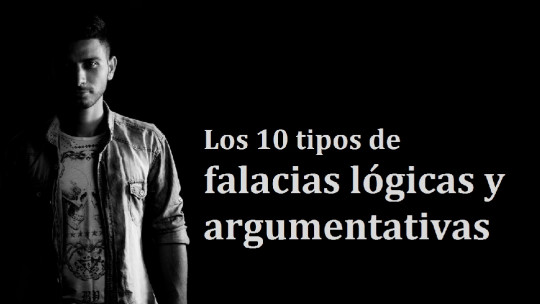All people long to be in possession of reason. When we keep an idea in our hearts it is because we consider it to be the best of all possible ideas in a given matter, and we rarely give in to abandon it without first fighting.
And that is why, by surrendering ourselves to the heat of the dialectical battle, Many times we use persuasion strategies that break with formal logic ; or we are victims of the tricks of others for taking our opinion to their field (and sometimes without realizing it).
We know this type of juggling of logic, which very often precisely ignores it and relegates it to a second order of importance, as fallacies. Sometimes such fallacies are cognitive biases that harm the user more than others.
In this article we will address, specifically, informal fallacies Knowing them is essential to develop sufficient competence with our words to emerge victorious in debates, as well as to protect ourselves from the traps that our mind (or other people) can occasionally set for us.
What are informal fallacies?
Informal fallacies are reasoning in which premises are used that apparently could be logical, but in reality hide an error in their own structure (the arguments have biases or refer to irrationality). On some occasions they have a sequence that at a formal level is impeccable, so they are not easy to recognize. The objective of this text is to shed light on this issue, and provide the necessary basis to identify them in ourselves or in others.
Types of informal fallacies
Next we will see what the 20 most important informal fallacies are, as well as what each of them consists of. In order to facilitate your complete understanding, we will also review specific examples.
1. Ad hominem
The ad hominem fallacy refers directly to the person who utters an argument, but does not at any time consider the veracity or logic of what he says The goal, in such a case, is to discredit the interlocutor or belittle his opinion based on “supposed” undesirable qualities, which undermine the strengths of his persuasion effort. For example: “if you are not a student at the university, you are totally ignorant, and you have no right to give your opinion on this matter.”
2. Ad baculum
The structure of an argument is supported in an illogical way, resorting to imposition, threat or violence in order to persuade others about carrying out an action or assuming an attitude as their own. The content of such messages lacks foundations of any kind, and usually occurs in the context of a vertical or asymmetric relationship (from the one who holds authority to the one who does not have it). For example: “this is done this way because I said so.”
3. Ad verecundiam
It is stated that a certain thing is true for the sole reason that the one who says it has a position of authority or is an expert on the issue at hand.
The prestige of the source is the only reason used to validate an argument, without considering the fact that people can make errors (or other types of biases) despite having deep knowledge. Sometimes it is also stated that something is true because it has been published in the media. For example: “that should be true, because they said it on TV.”
4. Ad populum
The general belief about the topic under discussion is used to infer, from it, that the position held on it is correct or truthful. From this fallacy It follows that the popular consensus undoubtedly indicates the correct , so the direction in which others think must be raised as the standard from which to guide one’s own vision of things. For example: “if this song is the first on the sales charts, it is because it must be good and worth listening to.”
5. Ad ignorantiam
Although the possibility of falsifying any hypothesis is a necessary characteristic for it to be considered in the field of science, this fallacy indicates that the inability to prove that something is wrong means that it must be true. Who uses it He does not consider it important to demonstrate the truth of what he is stating, but rather that the interlocutor proves its falsehood For example: “I have a lion in the garage, and if not, show me that I’m making it up.”
6. Ad antiquitatem
Traditions are for many people the basic guide to conduct themselves in life and in their decisions regarding how to proceed in the face of everyday uncertainty. In such a way, what is transmitted intergenerationally stands as the most basic rule, and the reason why something must be right or wrong. People who use this fallacy say that If a way of “doing things” was useful for a long time, it will continue to be useful in the present and in the future For example: “this is like this because it has been like this all my life.”
7. Ad novitatem
This fallacy can be considered a mirror of the previous one. In this sense, The veracity of any argument will be supported by referring to its novelty or the fact that it opposes what was once considered differently. Those who use it believe that the passage of time always leads to improvement, so everything that has emerged recently will replace what has been done by tradition. For example: “Today’s technology is so advanced that today’s movies are much better than those of twenty years ago.”
8. Post hoc ergo propter hoc
This fallacy is based on the misinterpretation of contiguity, in the sense that everything that happens before an event must be its reason. Although it is true that the laws of cause and effect would require the temporal (and physical) proximity of one and the other, Not everything that happens in the vicinity of an event will be directly related to it For example: “Everyone screamed the moment the teacher came into class, so that was the reason they did it.” It has also been called coincidental correlation.
9. Equivoque, ambiguity or antanaclasis
Polysemous words are used, or words that have multiple meanings , in order to offer a reasoning whose processing transfers the subject who could receive it to very ambiguous interpretations. On some occasions it is even possible that the connotations that arise from it are so discrepant that the intention to manipulate the listener is considered based on the “twisting” of the rich semantics of a language. For example: “the end of life is only death itself” (understanding “end” as “purpose” or as “end”).
10. Straw man
This fallacy consists of taking the argument of the person with whom you interact to its ultimate consequences, forcing them to assume the most extreme position possible and distancing them from moderation. In this way it is possible for a considered reasoning to become blurred and distorted, facilitating much simpler counterarguments.
This fallacy too involves misrepresentation of the original purpose , until it ends up becoming different and difficult to defend. For example: “If you say that all people are equal, and murderers are people after all, then you are like all murderers.”
11. Affirmation of the consequent
Every event can be divided into its causes and its consequences, or what is the same, into antecedents and consequences. Sometimes an event can have more than one consequence and, furthermore, when the latter occurs it is not necessary that it have been preceded by a single cause. This process leads to drawing conclusions that may be true, but that do not explore all the options that could come into play For example: “When it rains the ground gets wet. Since this ground is wet, it can be said that it has rained with complete certainty.”
12. Denial of antecedent
This case is opposite to the previous one. As in that case, it is necessary to break down a fact into its causes and consequences. After that, a cause would be treated as the “absolute value” for the implicated consequence, omitting in this act any additional explanatory factors for the consequent.
For example: “the person who works gets whatever he wants. If he doesn’t work, then he will never achieve it” (although he could do so through other means, such as chance, or by changing his goals for others in the that the work is not so relevant).
13. Hasty generalization
This fallacy implies that, based on a series of isolated personal experiences (which are not representative of reality), the generalization of a much more complex phenomenon is carried out. It is a mechanism through which a fact that is too complicated to be apprehended in a full and absolute manner is cognitively simplified, and through which unfair stereotypes are often born for those who bear them. For example: “I once went to the doctor and he made a mistake with my diagnosis, and they are all inept.”
14. Begging the question
This fallacy involves the articulation of premises that, by their very formulation, approve a series of assumptions that have not actually been validated. And this is so because, by accepting their content, other different aspects that could not be corroborated are secondarily accepted.
This way, If we agree with the original reasoning, others will be approved without us really realizing it For example: “I always tell the truth” (from which it will be deduced, without solid evidence, that he never lies).
15. Gambler’s Fallacy
This fallacy distorts the real laws of probability by paying attention to past events that really have no relevance It is used, above all, in issues related to chance and has been systematically verified in those who suffer from pathological gambling. It can be a problem when it encourages them to persist in the behavior that is leading them to financial ruin. For example: “When you toss the coin in the air, both heads and tails have up to a 50% chance of appearing. I have already done it nine times and each time it has come up heads, therefore it is more likely that the next time it will come up tails “.
16. Ad nauseam
The ad nauseam fallacy consists of repeating the same idea enough times to make it real for the interlocutor It is based on the premise that “when a lie is told over and over again it ends up becoming a truth.” This is a widely used strategy in the advertising sector, which aims to strengthen consumer confidence by reiterating the supposed advantages of a product or service in the different media. For example: “our toothpaste is the most effective for preventing cavities” (repeated on different channels and in multiple time slots).
17. Ad Misericordiam
This informal fallacy resorts to pity or pity in order to reinforce the appropriateness of what is intended to be achieved It involves a search for reason, or interpersonal persuasion, appealing to the emotions of the interlocutor and his empathy regarding our situation. Emotions play a relevant role here, since they are manipulated, ignoring the most basic logic. For example: “Please pass my exam, you don’t know how many days I’ve gone without sleeping…”.
18. Ad consequentiam
This fallacy suggests that if the consequences that follow from a premise are negative, it cannot be true. So, The arguments are stripped of their veracity because, if they were accepted, something that is not pleasant would be assumed or that can even become catastrophic. As can be seen, it is very close to denial, and has a very important emotional substrate. For example: “that thing about climate change is a hoax, because if it were true in just a few centuries the planet would go down.”
19. False dilemma
This fallacy aims to reduce a multiplicity of possible options to choose from in just two, often exclusive, alternatives. An artificial dilemma is thus created in which the person is forced not only to opt for any option among the few offered, but also to accept without further reflection the path that others have outlined for them. For example: “either you are with me or you are against me.”
20. Fallacy ad crumenam and ad lazarum
These fallacies They suppose the attribution of truth to the argument due to the fact that whoever uses it is rich (ad crumenam) or poor (ad lazarum). It is similar to the cognitive biases of the winner and the loser, a well-known phenomenon in Social Psychology that explains how people position themselves in favor of an individual because they are in a situation of privilege or disadvantage in a specific competitive context (especially in the politician). Thus, it focuses on resources, or the lack of them, as a criterion from which to recognize the goodness of discourses. For example: “If Bill Gates says it, it must be true.”









